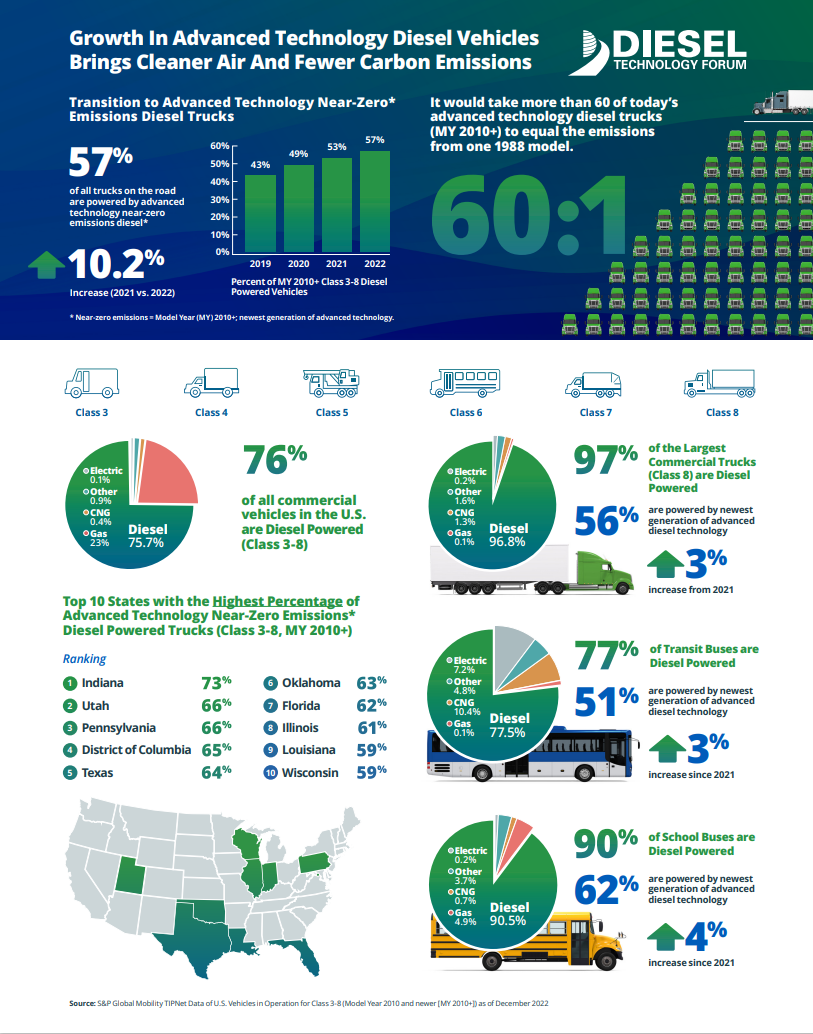US trucking companies are buying more new, low emission, diesel technology than ever. Research shows the number of new near-zero emission diesel trucks on the road increased 10.2% between 2021 and 2022 according to the Diesel Technology Forum (DTF). Near-zero emission trucks are advanced diesel technology manufactured in the 2010 and later model years.
According to DTF’s analysis of S&P Global Mobility TIPNet Vehicles in Operation Data as of December 2022:
- Diesel dominates the trucking sector. For Class 8 commercial trucks in operation that are 2010 or later model years, advanced diesel technology make up 95.4%; 2.1% CNG, 0.3% electric, and gasoline or other fuels as the remainder. For the entire (Class 3-8) commercial truck population of over 15 million vehicles, 75.6% are powered by diesel, gasoline (22.9%), compressed natural gas (0.46%), other (ethanol, fuel cell, LNG, propane, 0.85%), and electric (0.09%). Illinois has the fastest-growing registration of new advanced diesel technology Class 8 trucks, up 4.6% in 2022 compared to 2021.
- The population of near-zero emissions diesel technology trucks is growing. They comprise 57% of all commercial diesel trucks (Class 3-8) on the roads today. These trucks feature particulate filters and selective catalytic reduction systems (SCR) that achieve near-zero levels of emissions. That’s a 10.2% increase in one year (2022 vs 2021).
- 65.7% of all commercial diesel trucks (Class 3-8) are 2007 and newer; particulate filters help them achieve near-zero emissions for particulates.
- Indiana ranks first for the highest percentage of registrations of 2010 and later model year near-zero emission diesel trucks (73.2%). Next, Utah (66.2%), Pennsylvania (66.0%), the District of Columbia (65.4%), Texas (63.6%), Oklahoma (62.6%), Florida (62.3%), Illinois (60.6%), Louisiana (59.2%), and Wisconsin (59.1%). California lags the national average, taking the 35th spot (51.6%).
- California roads feature 125 times more new-generation advanced diesel trucks than electric trucks.

TECHNOLOGY THAT’S HERE TO STAY
Diesel technology has fundamentally transformed over the last decade with advancements leading to achieving near-zero emissions beginning with the 2010 model year. Its continued dominance in trucking reflects diesel’s record of continuous improvement as well as low-cost operation. We see the next milestone for diesel technology emerging in California in 2024 and elsewhere across the country in 2027. That next generation of diesel will further reduce NOx emissions by an additional 50-80% over current models.
“Nearly 7 million new-technology diesel trucks are on the roads, delivering our goods and services with near-zero emissions,” says Allen Schaeffer, executive director of the Forum. “Nationwide, for every electric commercial truck on the road, there are nearly 1,100 powered by internal combustion engines.”
“According to this most recent analysis, internal combustion engines (diesel, gasoline, natural gas, and propane) power about 99.91% of the nation’s trucking fleet. As the trucking industry explores new fuels, including all electric and fuel cell technology, it is clear that diesel and other internal combustion engines are going to continue to play a dominant role for years to come,” he says.
LOW-EMISSION FUEL WITH NO COMPROMISES
No other fuel yet matches the full combination of what the newest generation of diesel technology offers. This includes efficient performance as well as reliability, durability, low-cost operation, high market value for used products, maximum driving range, flexibility in usage, routing, and ready access to servicing, parts, and fueling throughout the nation. Alternative technologies may hold promise, but they require compromise, have higher upfront costs, and limited infrastructure for fueling and service.
“Decarbonizing the economy will take time and require many different types of solutions for different sectors,” Schaeffer says. “There isn’t a one-size or one-fuel fits all answer. In the meantime, accelerating the turnover of the existing fleet, continued improvement of internal combustion engines, and utilizing low-carbon renewable fuels is just as important as a zero emission vehicle approach to help achieve meaningful progress toward climate goals.”
Find out more, visit www.dieselforum.org.




